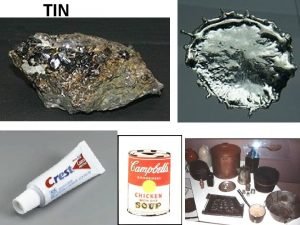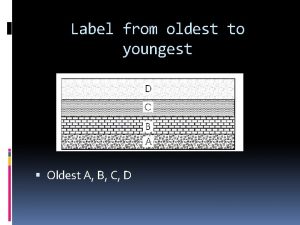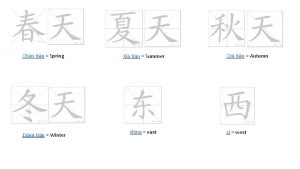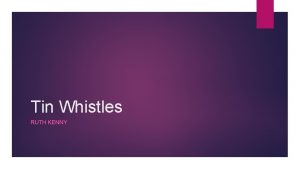TIN HISTORY Tin is one of the oldest










- Slides: 10

TIN

HISTORY • Tin is one of the oldest metals known by man. There are domestic utensils and arms made of brass (copper with about 15% of tin), dating from 3500 B. C. . • The Phoenicians had a very important role in the spread of brass utensils due to its commercial trades with Britain, Spain and the Middle East. • Pliny referred, in 49 A. D. , to the existence of tin and lead alloys, what we now know as solder, as well as recipients of tinned copper. • Tinned iron was only developed in the 14 th century in Bohemia, and tinned steel appeared only in the 17 th century. • Originally confined to Britain and Spain, the tin extraction spread throughout to other countries of the Southern Asia and to Congo, Nigeria and Bolivia.

SOURCE • Tin is found mainly in the ore cassiterite, which is found in Malaysia, Bolivia, Indonesia, Thailand Nigeria. It is obtained commercially by reducing the ore with coal in a reverberatory furnace. • Tin is found as vein tin or stream tin. The tin ore is stannic oxide and is generally found with quartz, feldspar or mica. The ore is a hard , heavy and inert substance and is generally found as outcroppings as softer impurities are washed away

PROPERTIES • Tin is soft. • Tin is highly corrosion-resistant and fatigueresistant. • Tin is non-toxic. • Tin is highly malleable (able to be shaped). • Tin alloys easily with other metals. • Tin has a low melting point (232°C). • Tin is easy to recycle. • The word tin is Anglo-Saxon in origin, but the symbol for tin, Sn, comes from the Roman word Stannum.

USES USE DESCRIPTION Tinplate About 50% of tin is used as tinplate for canned foods and drinks, where steel cans are coated with tin to make them rust-resistant, more attractive, and more easily shaped and soldered. (Steel alone would rust, and tin alone would be too soft and too expensive). Solder About 30% of tin is used as a tin-lead solder in electronic parts, plumbing, machinery, and cars. Bronze An alloy of copper and tin – used for statues, bearings in car engines and heavy machinery, and musical instruments such as bells, cymbals and gongs Pottery and Tin oxide is used as a white glaze on pottery (including tiles) or glassware, glass making and can be coloured with other metal oxides. Plate glass is made by floating molten glass on a bath of molten tin while it solidifies, giving the glass a very flat and polished surface. Other In biocides (such as wood preservatives and disinfectants), making dyes, plating baths, making perfumes and soaps, making plastics, strengthening glass bottles, in toothpaste, in veterinary medicines, church organ pipes (lead -tin alloy), cast iron, fire retardants, pewter (mostly tin, with antimony, copper and lead, and used for beer tankards, candlesticks, salt and pepper shakers etc), dental fillings and tinsel (60 -40 tinlead alloy).

USES: • • • Tin has many uses. Electro-plating is an important application of tin. It can be done through the electroplating of a small coat of tin around objects of steel, copper, aluminum etc. The tinned pieces have countless applications such as in kitchen utensils, spray recipients and shaving foam, ink cans, electronic components, integrated circuits, clips, pins and many other. Tinned objects can also be used with ornamental purposes. As a pure metal, . It can still be used in storage tanks for pharmaceutical chemical solutions, in capacitors electrodes, fuse-wires, ammunitions, tinned iron sheets to protect victuals, sweets or tobacco etc. Some of the tin organic compounds have several application as fungicides and insecticides for the agriculture and still as wood, textile and paper preservers. Alloys of tin are also important, such as soft solder, pewter, bronze and phosphor bronze. The most important tin salt used is tin (II) chloride which is used as a reducing agent and as a mordant. Tin salts sprayed onto glass are used to produce electrically conductive coatings. Most window glass is made by floating molten glass on molten tin to produce a flat surface. Recently, a tin-niobium alloy that is superconductive at very low temperatures has attracted interest. The more important tin compound is the tin dioxide (Sn. O 2), used in electric resistors and dielectrics, and the tin monoxide that it is used in the production of tin salts for electroplating and as chemical reagents. The tin compounds that contain lead, barium, calcium and copper are indispensable in the production of electric capacitors. The tin fluoride is used as addictive in toothpastes

TIN PRODUCTION

World Mine Production and Reserves United States Australia Bolivia Brazil China Congo (Kinshasa) Indonesia Malaysia Peru Portugal Russia Thailand Vietnam Other countries World total (rounded) Mine production 2009 2010 e — — 1, 400 2, 000 19, 000 16, 000 13, 000 12, 000 115, 000 9, 400 9, 000 55, 000 60, 000 2, 380 2, 000 37, 500 38, 000 30 100 1, 200 1, 000 120 100 3, 500 2, 000 260, 000 261, 000 Reserves 3 — 180, 000 400, 000 590, 000 1, 500, 000 NA 800, 000 250, 000 710, 000 70, 000 350, 000 170, 000 NA 180, 000 5, 200, 000

TIN MINING COUNTRIES • Malaysia – Peninsular Malaysia and Kinta valley – Larut Plain around Taiping, the Kelang valley around Kuala Lumpur, the Jelebu valley of Negri Sembilan, Jemaluang and Kota Tinggi in Southern Johore and Sungei Lembling in Pehang • Thailand – South of the country in the Kra peninsula and on off shore Island like Phuket – Major mining centres are Ronong, Phangnga and Takuapa • China – Yunnan at Gejiu – In south eastern part Tauchin and Hexian (Hohsein), Nanling Shan in Central China • Indonesia – Islands of northern coast of Sumatra including Bangka, Billiton and Singkep

• Also mined in continents of Asia , Myanmar and Vietnam • Bolivia – Andes mountains, Potosi and Oruro • Nigeria – Bouchi plateau • Bouchi, Jos and Zaria • Zaire – Monono and Maniema • Australia –nominal quantities of tin. • North America is devoid of tin resources


















